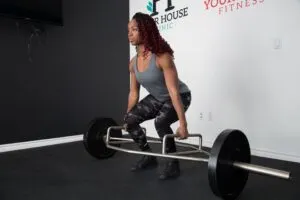Some of the links in this post are affiliate links. This means if you click on the link and purchase the item, we will receive an affiliate commission from the vendor at no extra cost to you. These business relationships allow us to keep bringing you great EatMoveHack content. All opinions remain our own.
Here at Eat.Move.Hack. we are going to bring you our favorite workouts. The workouts that we do in our own basement each morning. We are going to call these are Basement Series workouts because you can do them in your own basement with minimal equipment. We have already brought you one workout that was the foundation of our ongoing series – 10,000 Kettlebell Swing Challenge – and More. Today we are bringing you a variation an evolution of this original workout – this is our battle rope full-body workout.
Battle Rope Full-Body Workout Structure
 This workout will follow the same general structure as the 10,000 Kettlebell Swing workout.
This workout will follow the same general structure as the 10,000 Kettlebell Swing workout.
This means that it will be broken up into 4 main movements. These movements will focus on 4 areas:
- High volume movement (this is the battle rope portion of this workout)
- Upper body/Chest focused movement (in this workout that will be dips)
- Upper body/Back focused (in this workout that will be single-arm kettlebell rows)
- Lower Body (in this workout this will be deadlifts)
The workout will be a 60-minute workout, but you can adjust to go longer or shorter. We really like the one hour mark, but that’s just our preference.
Our high volume movement, battle ropes, will be done every other minute – this will result in 30 rounds of battle ropes. We set the battle rope session for 15 seconds per round.
The chest focused movement (dips) was done every four minutes. This means that you will do 15 rounds of dips.
The back focused movement (single-arm kettlebell rows) was done every eighth minute. You will get in either 8 rounds of kettlebell rows or deadlifts, depending on which one you put in the cycle first.
The lower body movement (deadlifts) was also done every eighth minute. If you put deadlifts into the cycle after the kettlebell rows then you will get 7 rounds.
This is how your repeating 8-minute cycle will look:
- Battle ropes
- Dips
- Battle ropes
- Single-arm kettlebell rows
- Battle ropes
- Dips
- Battle ropes
- Deadlifts
You will repeat this 8-minute cycle for as many rounds as you want. If you go 60 minutes then you will get 7 1/2 rounds.
Battle Rope Benefits
If you have ever wrangled with battle ropes then you know how effective they can be. If you haven’t, then, by all means, find an opportunity to get your hands on a rope. It is an old school and simple training tool.
Battle ropes are sized both by diameter and length. The greater the diameter of the rope the heavier the rope will be. This will make it harder.
The longer the rope, the heavier the rope, and the harder the exercise will be. A rope with a large diameter and long length will be the hardest. A small diameter short rope will be the easiest.
This is the rope that I use – I’m 6’7” and 235 pounds. It is 2″ in diameter and 30′ long.
This is the rope that my wife uses. it is 1.5″ in diameter and 30′ long. This 1/2 inch difference in diameter makes a huge difference.
Now onto the battle rope benefits:
- Great cardio workout
- Full body workout
- Back and arm blaster (if you are using the right weight rope)
- Core centric movement (you have to stabilize while using the ropes – your core handles this)
- Increased flexibility (both through your shoulders and hips)
- A lot of available variety in how you use the ropes
Battle Rope Anchor
You want to make sure that your battle rope anchor point is secure. Once you really start using the ropes it will create a rhythmic movement that creates a lot of force.
We loop our ropes around our pull up rack. This rack probably weighs about 200 pounds. This holds the ropes well.
We have also used my pickup truck trailer hitch to be a battle rope anchor as well. To make this work you will need an attachment for your rope, like this – Battle Rope Anchor.
You can also loop your battle rope around a tree, post, or any secure location that can withstand the rhythmic movement of the ropes.
We have also used heavy kettlebells or dumbbells as well. If you are going to use this option try to put the “weight” in the grass so that it has more friction.
Secondary Movements
 So, this is primarily a battle rope workout but don’t forget about the other movements.
So, this is primarily a battle rope workout but don’t forget about the other movements.
The dips are pretty self-explanatory. You will either need a dip rack to do these or you can use a dip station (this is the one we use) or an elevated bench/wall, etc. If you aren’t able to do a full dip yet then you can start with dip holds. Once you are able to do dip holds for 15-20 seconds you start using negatives to help you progress. You can set your rep goal based on your capabilities. When were are doing unweighted dips we shoot for 8-10 depending on general fatigue.
Single-arm kettlebell rows. We have kettlebells in our basement so these are the tools we use for these. But, you could use a dumbbell or do a standard barbell row if you have access. You can also use resistance bands to get your back focus in this workout. On each round of this movement, we work each arm and shoot for 10 reps per arm.
On the deadlift, you have a lot of flexibility. We mix it up regularly. We will do double kettlebell deadlifts, single-leg lifts, as well as trap bar deadlifts. Just use the equipment that you have access to for all these workouts. We shoot for 8-10 reps of these based upon the weight we are using.
Conclusion
We’ve been asked regularly about our basement workouts, so we are committed to bringing you our workouts. We craft these workouts to be flexible and customizable with a bit of creativity. The core qualities that we shoot for are workouts that are full-body and able to be completed in less than an hour.
Make sure to check out our Move page for more workout ideas and be sure to check back regularly for updates to our basement series.

